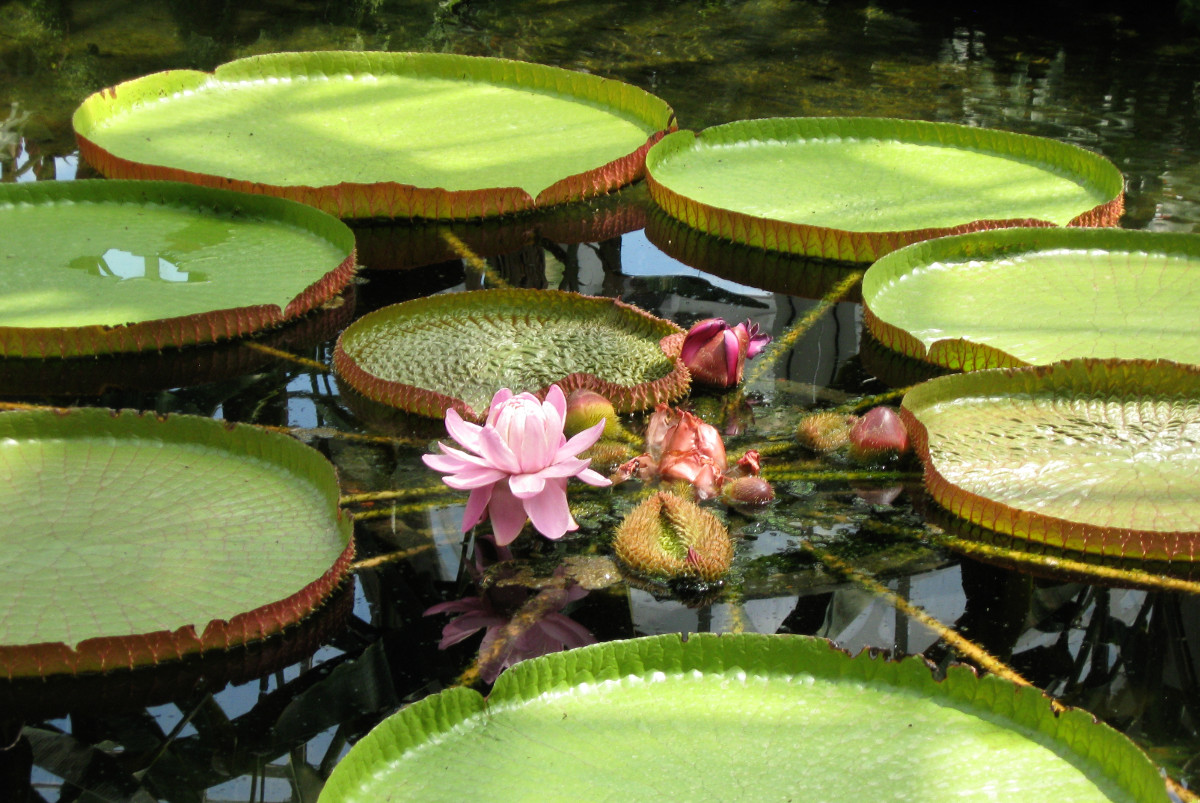Benutzer-Werkzeuge
Victoria amazonica (Poepp.) J. C. Sowerby - syn. Euryale amazonica Poepp.; Nymphaea victoria R. H. Schomb. ex Lindl.; Victoria amazonica Planch. ex Casp.; Victoria regia Lindl. - Nymphaeaceae
Amazon water lily, royal water lily, Victoria lily, Amazonas-Riesenseerose, Königliche Wasserlilie
Water plant, native to tropical South America, cultivated elsewhere; leaves floating, circular, up to 2.5m in diameter; flowers nocturnal, changing color from white (fragrant) to pink (not fragrant).
„The Victoria's nocturnal flowers are impressive, as is their bizarre pollination biology. The flowers open a pure white on their first night and emit a strong pineapple-like scent. This attracts the scarab beetle pollinator (Cylocephata castaneal) to the flower, which is functionally female that evening and receptive to pollen brought by the beetle. As daybreak approaches, the flower begins to close, trapping the beetle inside. During the day the flower becomes functionally male, indicated by the maturation of the anthers and the release of pollen. The beetle becomes coated with the pollen, but cannot fertilize the flower because it is now functionally male. The flower opens the second evening, having changed color from white to pink. The beetle is released and seeks out another white, fragrant, receptive flower, where it will deposit pollen to allow seed set.“
[Jennifer Davit, Victoria: The Reigning Queen of Waterlilies, Fairchild Tropical Botanical Garden 2007] http://virtualherbarium.org/gardenviews/victoriaamazonica.html
Main components of the fragrance of uncut Victoria flowers (dynamic headspace; GC-MS) were methyl 2-methylbutyrate (66.3%), methyl tiglate (26.1%), benzyl 2-methylpropionate (2.7%), methyl 2-methylpropionate (0.7%), methyl hexanoate (0.5%), benzylalcohol (0.5%), methyl butyrate (0.3%), and methyl (E)-hex-2-enoate (0.2%).
[Kite, G., T. Reynolds, and G. T. Prance. „Potential pollinator-attracting chemicals from Victoria (Nymphaeaceae).“ Biochemical Systematics and Ecology 19.7 (1991): 535-539] see also [Dragoco Report 1997, 2, 63-71]
Headspace analysis of the strong sweet fruity flower scent showed methyl 2-methylbutyrate (19.9%) and methyl tiglate (65.0%) as main constituents. Minor components were several methyl esters of C4-C6 acids including methyl thiogtiglate (0.05%), furthermore 1-octen-3-ol (1.0%), methyl nicotinate (0.8%), methyl 1H-pyrrole-2-carboxylate (0.6%), and methyl (E,Z)-2,4-decadienoate (2.9%) e.g.
[Meaningful Scents around the World, Roman Kaiser, Zürich 2006, 109-113 and 269]

Victoria Lily (Victoria amazonica) in the Victoria Room at Phipps Conservatory, Pittsburgh 2015
https://commons.wikimedia.org/wiki/File:Victoria_amazonica,_2015-08-08,_Phipps_Conservatory,_08.jpg, Author: Cbaile19, CC0
